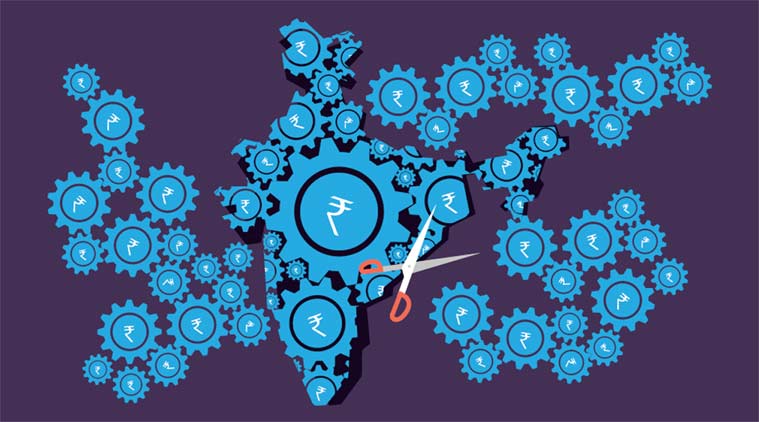- India
- International
‘GST is one of the boldest reforms in post-Independence India’
Goods and services tax, which will facilitate the movement of commodities and lead to expansion of economic activity, is one of the boldest reforms in post-Independence India.
 GST may also lead to a new thinking on the role of tax incentives in India. (Illustration by C R Sasikumar)
GST may also lead to a new thinking on the role of tax incentives in India. (Illustration by C R Sasikumar)
The passing of the constitutional amendment bill (CAB) for framing the law for setting up the goods and services tax (GST) regime heralds truly transformational reform in India. It will not only aid the ease of doing business but also re-engineer business processes of companies. To quote Victor Hugo,”This is an idea whose time has come”.
The abolition of Entry 52 of List II (Under Schedule VII) of the constitution would do away with entry tax. This, combined with the abolition of octroi and purchase tax, would create a truly common market. There will be a free movement of goods and services across the country. It would also have the effect of expanding the market as more actors are likely to enter the economic space. The impact of this would be similar to the impact that the de-materialisation of shares had on the capital markets: By eliminating the hassle of material transfer of shares, the move encouraged more investors to enter the share market.
GST would most positively impact the organised manufacturing and the Make in India campaign for goods. It is likely to benefit organised manufacturing in the following ways:
It is likely to bring down the present incidence of taxation on goods from 26.5 percent to 15-20 per cent. The removal of the inter-state barriers facilitating the free flow of goods and services is likely to reduce the logistics costs faced by the industry, bring them down to the world average of about 8 per cent.
Negative protectionism faced by Indian industry will come down as the countervailing duty is likely to fully compensate the domestic duties faced by the Indian industry. The inventory costs of industry are likely to go down.

As a destination-based tax, GST has an equity dimension. The developing states of India being consumption -oriented are likely to benefit from the introduction of the tax. This will aid in bringing greater investments in the social and economic sectors. GST will also have a political dimension: It will bring the Centre and states together in new arrangements of fiscal engagement. However, each state will need to create organisational structures in the form of a GST secretariat which will bring together senior officers of the Central Board of Excise and Customs and state tax officers. The secretariat should be registered under the Societies Act and must be provided with a dedicated administrative secretariat and funds. Many of the anticipated implementation issues could be sorted out once the state GST secretariats are in place.
GST may also lead to a new thinking on the role of tax incentives in India. Numerous studies have proven that tax incentives are not the ideal way to encourage industry and attract investments. These incentives often do not meet the socio-economic objectives that they are designed to fulfill as they transfer resources from the poor to the not-so-poor. The industry is better supported through upfront budgetary allocations from the line ministries.
Although the CAB provides the framework for the implementation of dual GST, actual implementation will depend on the framing of the legislation. The GST model law was placed in the public domain to obtain the responses of all stakeholders. While the law has many redeeming features, there are three areas which need tweaking: Dispute resolution, valuation and centralised registration for certain pan-India services like banking, insurance and telecom.
In the area of dispute resolution, a conceptual distinction needs to be made between offence cases and assessment cases. While offence cases could be decided by field officers, binding instructions must be issued by a centralised technical secretariat attached to the tax research unit for assessment cases. This suggestion is based on the principle that those who draft the law must also interpret the law. The provision relating to valuation in the model GST law is a retrogressive one and could present several challenges.
The concept of transaction value embedded in the determination of valuation is wholly inappropriate: It is a throwback to the central excise era where “manufacturing” is the taxable event. In the GST scenario, where both the Centre and state are going to tax concurrently along the value chain, transaction value will create concerns for trade and industry. The appropriate solution lies in taking recourse to the invoice value, representing the amount actually paid or payable. In the case of self-supplies, the self-declared transfer value must be deemed as appropriate invoice and accepted by the department. These changes will considerably simplify the valuation provisions and facilitate ease of doing business. Finally, certain pan-India services must be brought under a scheme of centralised registration using the large taxpayer unit infrastructure. They would otherwise be subject to multiple registrations and complex documentation.
The introduction of GST is a bold reform measure in post-Independence India. To quote Arvind Subramanian, chief economic advisor, “The GST will facilitate ‘Make in India’ by ‘Making One India”.
EXPRESS OPINION
More Explained
Apr 20: Latest News
- 01
- 02
- 03
- 04
- 05









































